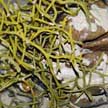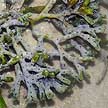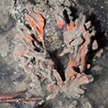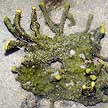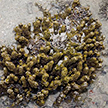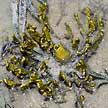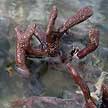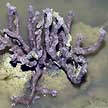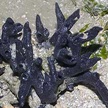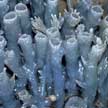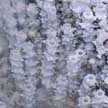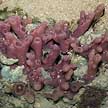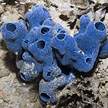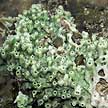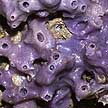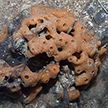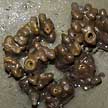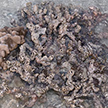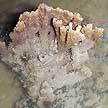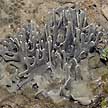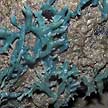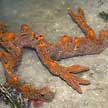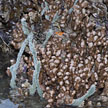Photo
index of sponges on Singapore shores
Branching
or lumpy sponges* |
|
|
|
|
|
| Stems
15-20cm long, 1cm in wide with holes along the length. The stems are
often in a tangle. Bluish to olive green. Among coral rubble. Sometimes
seen on some of our Southern shores. |
Bright
orange long skinny strings about 0.2cm in diameter, in a tangled jumble
that may be 20cm wide. Sometimes seen on Beting Bronok. |
About
20-30cm across, 'stems' about 1-2cm wide. Feels wooly, velvety, spongey
or felt-like. No holes along the 'stems'. On coral rubble. Commonly
seen on many of our Southern shores. |
About
20-30cm across, 'stems' about 1-2cm wide. Feels wooly, velvety, spongey
or felt-like. With regularly spaced holes along the 'stems'. On coral
rubble. Sometimes seen on our Southern shores. |
Fat flattened leaves or lobes (10-15cm). Covered with thin long hairs that traps sediments and hides the bright
orange colour. Sometimes seen on Beting Bronok. |
|
|
|
|
|
| Knobs
or branches (8-12cm) from an encrusting base (20-30cm). Surface rubbery
with small raised pointed bumps. Little holes spaced far apart. Yellow
to olive. On coral rubble. Sometimes seen on our Southern shores. |
Short fingers (2-5cm) from an encrusting base (20-30cm). Surface rubbery
with small raised pointed bumps. Large holes spaced far apart. Uniformly mustard, yellowm olive. On coral rubble. Sometimes seen on our Southern shores. |
20cm.
A central tube-like structure, encircled by finger-like extensions.
Yellow, black, brown, greenish. On and among coral rubble, also rocks
that stay submerged. Commonly seen on many of our shores. |
Knobs
or branches (4-10cm) from an encrusting base. Small hole at the rounded
tips. Chocolatey brown also yellow. On coral rubble Sometimes seen
on our Southern shores. |
|
|
|
|
|
|
| Looks like a bunch of long stems, usually growing upright but sometimes
sprawling horizontally. Each branch about 1-1.5cm thick and 10-15cm
long with large regularly spaced holes, and rough texture. Purple
to lilac. On stones and hard surfaces near the mid-water mark. Commonly
seen on our Northern shores. |
About
20cm. Branches in all directions, tapering to elegant points. Each
branch thick (about 3-4cm in diameter). Deep black. Sometimes seen
on our Northern shores. |
10-15cm
wide. Narrow hollow tubes (4-6cm tall 1cm wide) packed closely together.
In some, the tubes may have short spikes on the sides. Beige to pale
blue. On coral rubble. Commonly seen on some undisturbed Northern
shores. |
10-20cm
wide. Narrow hollow tubes (1cm wide) regularly ringed with large neat
spikes, forming a star-like shape around the large hole at the tip
of the tube. Colour lilac to bluish. On coral rubble. Commonly seen
on some undisturbed Northern shores. |
10-15cm
in diameter. Encrusting with short hollow lumps, lumps may be tall
so they are tubular. Bright pink. On coral rubble. Commonly seen on
our undisturbed Northern shores. |
|
|
|
|
|
| 6-10cm.
Encrusting with lumps, each lump with a large hole at the tip, surface
texture rough. Bright electric blue. On coral rubble. Commonly seen
on some of our Northern shores. |
10-15cm.
Encrusting with short hollow lumps, lumps may be tall so they are
tubular. Colour pale green to olive. On coral rubble. Commonly seen
on our undisturbed Northern shores. |
10-15cm.
Encrusting with short hollow lump. Colour bright purple. On coral
rubble. Sometimes seen on our shores. |
10-15cm.
Encrusting with short hollow lump. Colour orange. On hard surfaces. Sometimes seen on our Northern shores. |
10-20cm
wide. Irregular clump of smooth lumps or blunt tipped cones, some
with large holes at the tips. Chocolate brown. On the ground at mid-water
mark near seagrasses. Common on some of our Southern shores. |
|
|
|
|
|
| 10-15cm
wide. Irregular clump of crumbly lumps or thick branches. Brown. Sometimes seen on some of our shores. |
A
few short thick branches 6-8cm long, about 1-2cm wide. There may be
a large shallow hole at the tip of a branch. Neon to dusky pink. Sometimes
seen on some of our Southern shores. |
10-15cm.
Encrusting, prickly surface, often with flat projections. Usually
pale greyish blue. On coral rubble. Sometimes seen on our Southern
shores. |
|
|
|
|
|
|
|
| Area
to 30cm. Looks like thin spreading roots, with spikes, knobs and tubes
along the length. Branches thin (about 2cm wide) tapering to points
with holes along the length. Blue, green, yellow, purple. On hard
surfaces near mid-water mark. Commonly seen on many of our Northern
shores. |
25-30cm.
Looks like tree roots, branching sparsely along the surface, with
knobs or fat spikes along the length. Branches 25-30cm long and 3-4cm
thick. Bright orange. On coral rubble near seagrasses. Commonly seen
on some of our Southern shores with seagrasses. |
Cluster
of a few stems long (10-20cm), sparsely branched, cylindrical covered
with long spiky 'thorns'. Colours blue or greenish blue. Sometimes
seen on our Southern shores. |
|
|
*Sponge species are
difficult to positively identify without close examination.
On this website, they are grouped by external features for convenience of
display. |
|
|
|
|
photo
index of
sponges on this site
|
|
|

